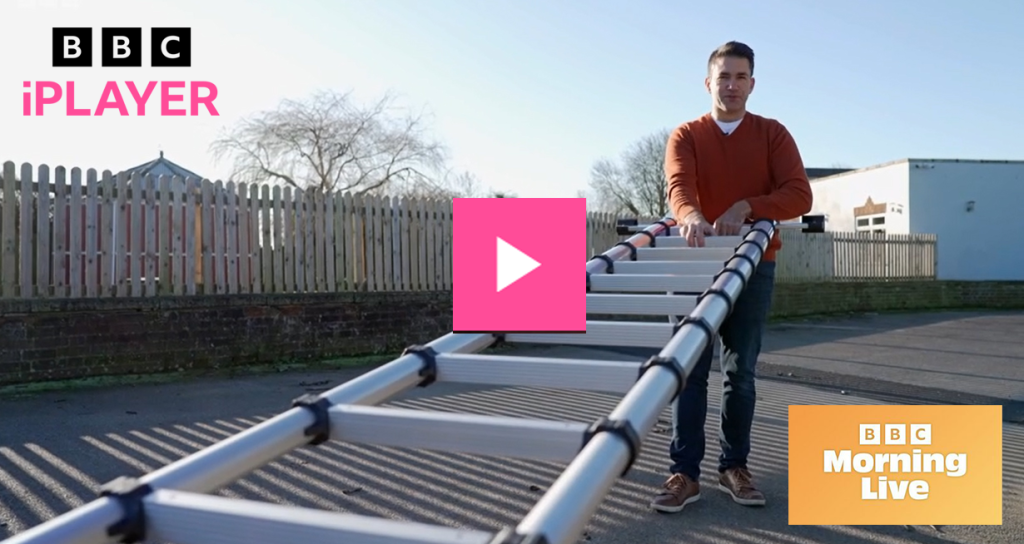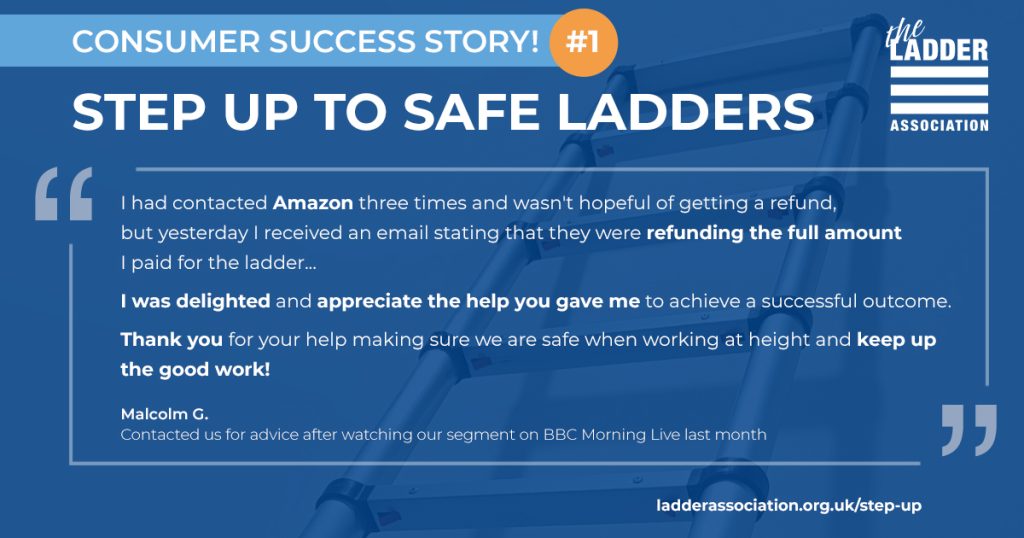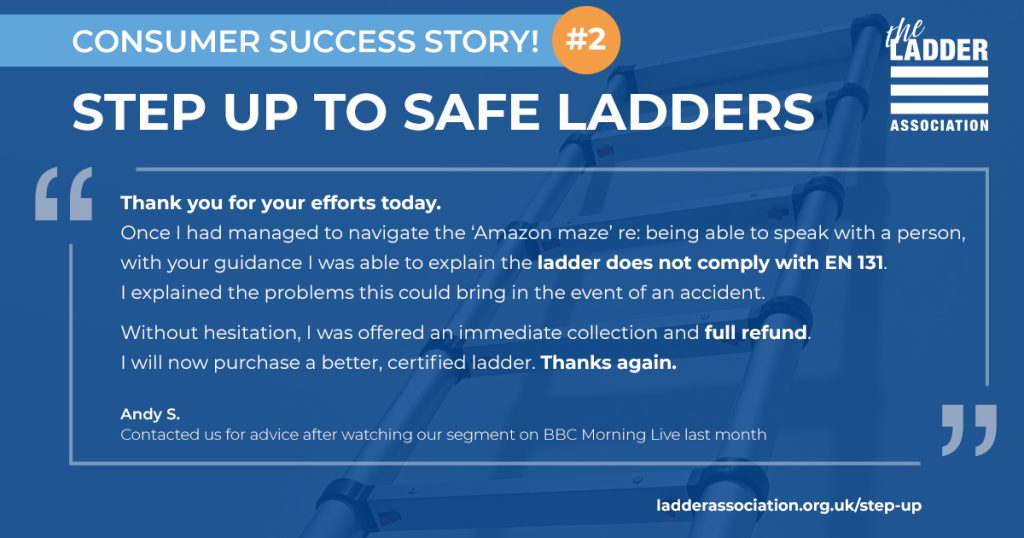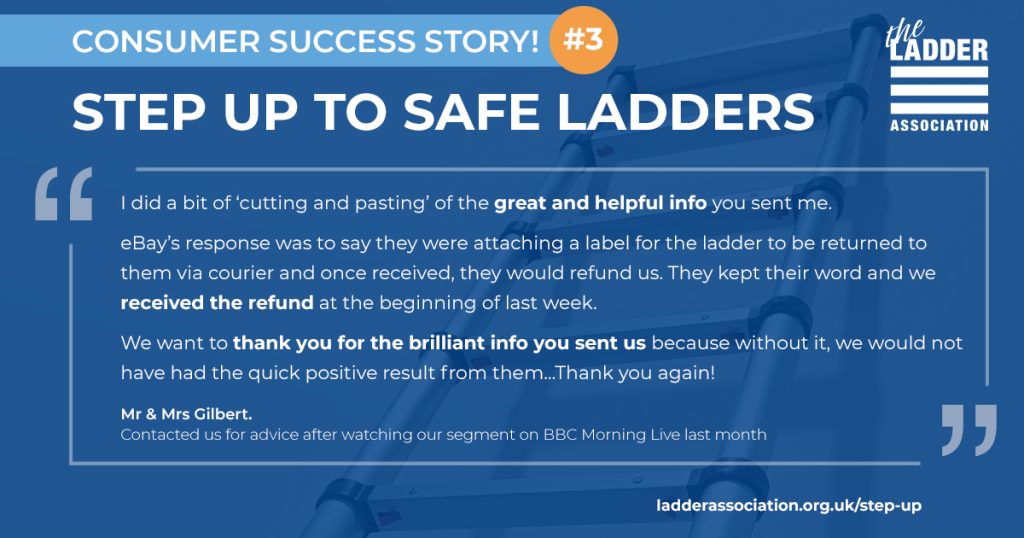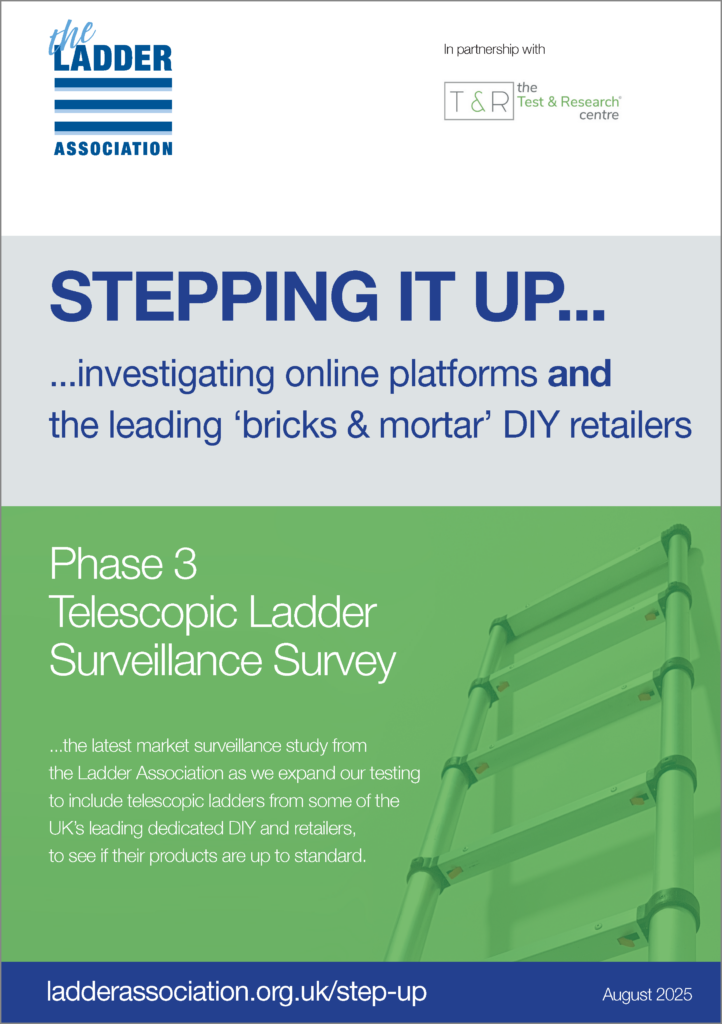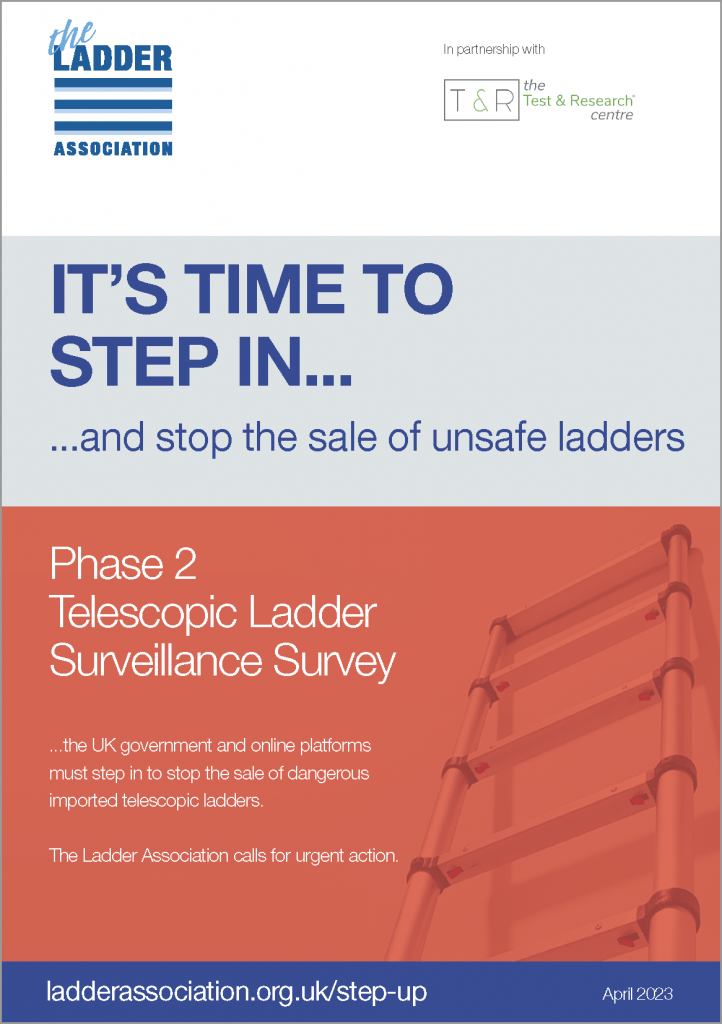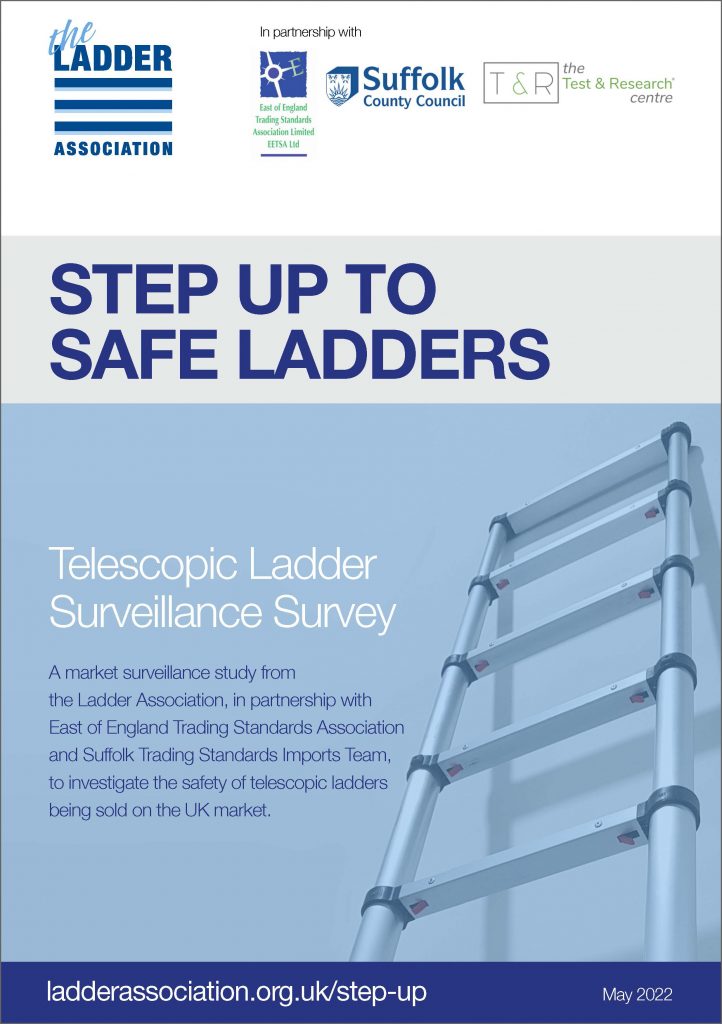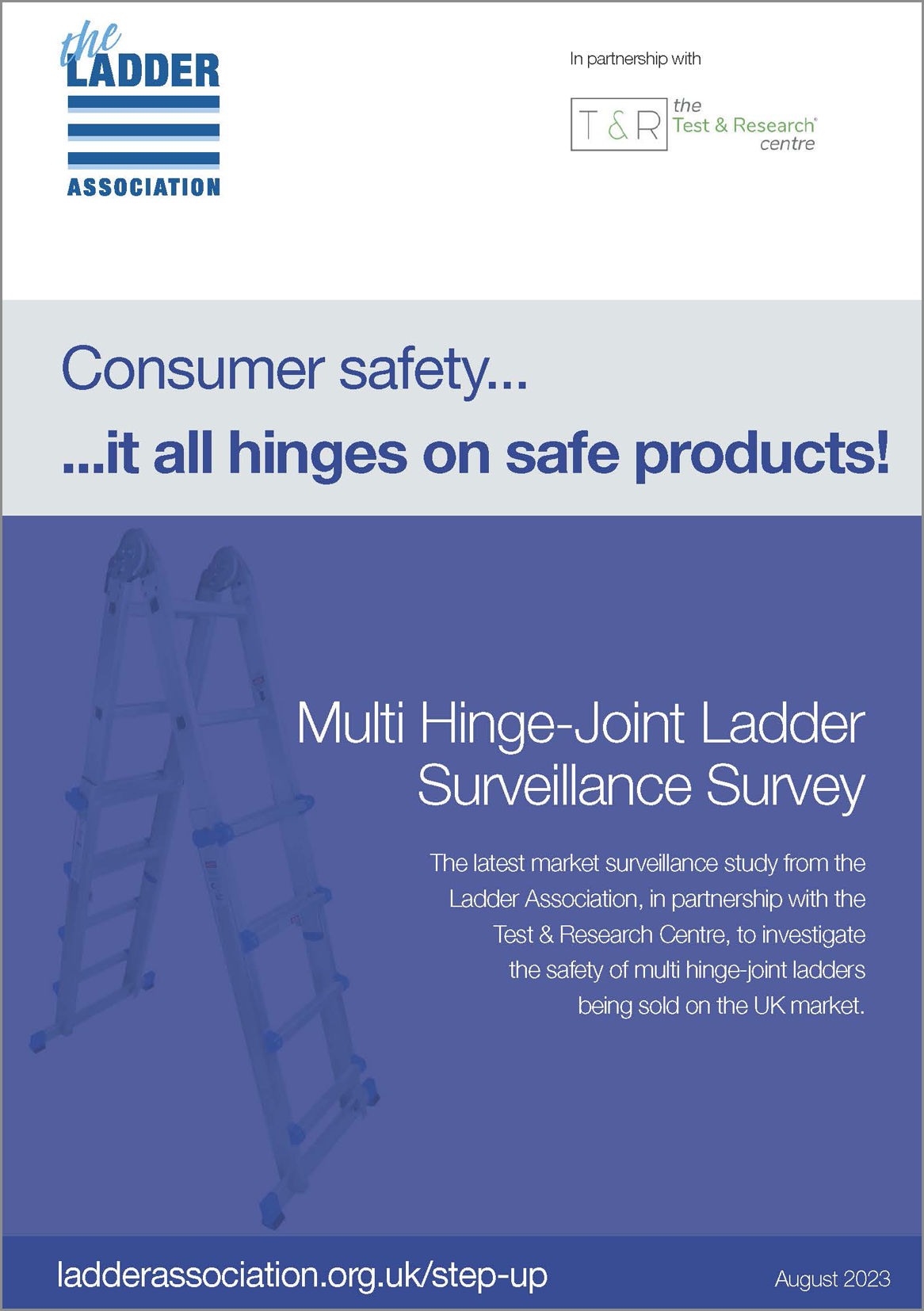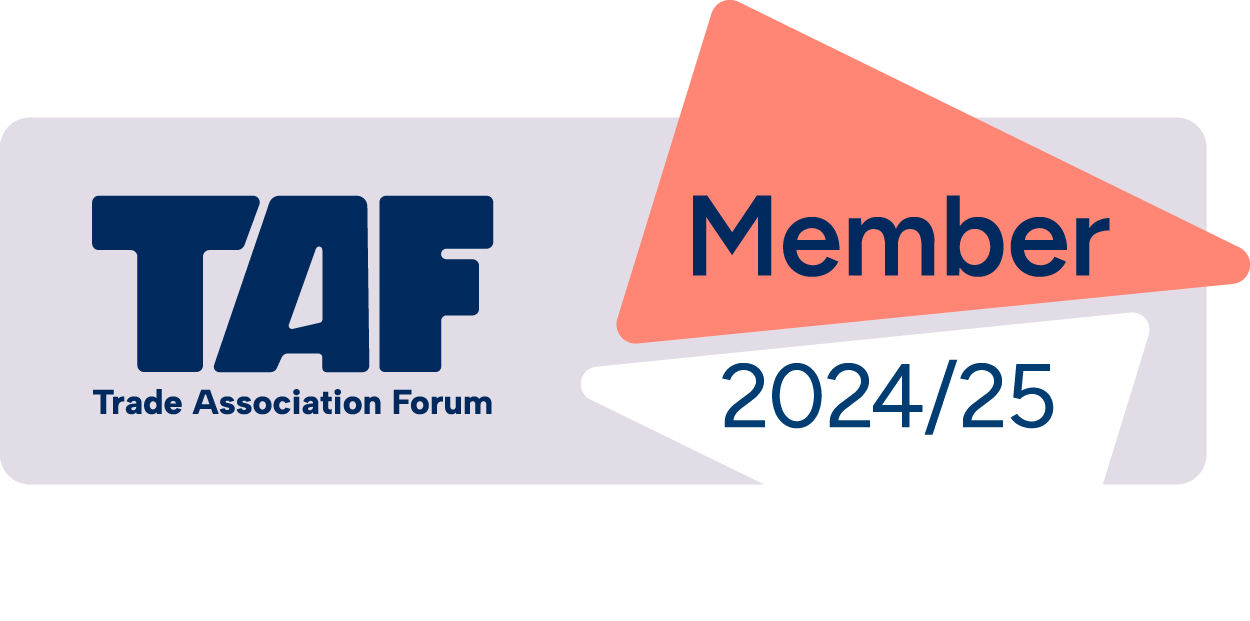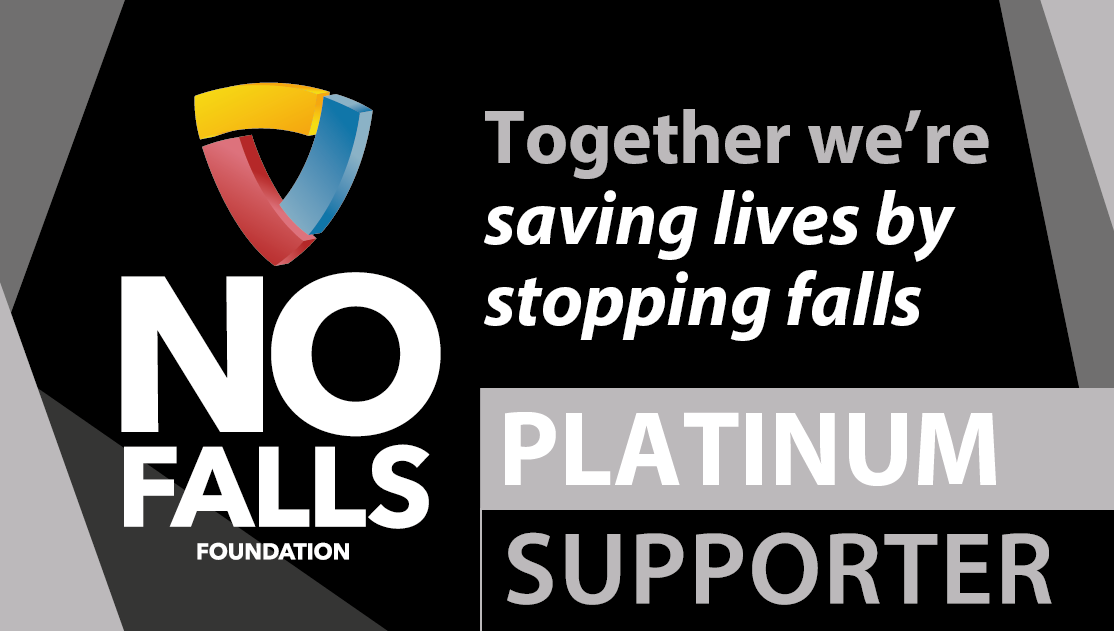As Featured on BBC Morning Live!
Did you know that online platforms take little or no responsibility for the safety of the products sold on their sites?
The Ladder Association were delighted to be featured on BBC Morning Live on 21 January 2025, highlighting the real and serious dangers of substandard imported telescopic ladders available for sale to UK consumers via online platforms.
The segment, part of our ongoing ‘Step Up to Safe Ladders’ campaign, saw us put 3 ladders we bought from Amazon and eBay to the test.
Spoiler alert: sadly (but unsurprisingly) all 3 samples failed the strength tests before the full test load was applied. These ladders claimed to meet current product standard EN 131, but when tested during filming, did not meet the minimum safety requirements, posing serious risk to the user when used in real-life.
Consumer success stories following the programme...
Click the images below to enlarge:
Our 'Step Up to Safe Ladders' campaign
Background
The Ladder Association has been highlighting the real and serious issue of the availability and use of substandard imported ladders on the UK market for many years.
Our ongoing ladder safety campaign, ‘Step Up to Safe Ladders’, began by highlighting the very real dangers of poor-quality telescopic ladders on the market. Since then, we’ve carried out several follow-up telescopic ladder surveillance studies as well as safety testing on multi hinge-joint (multipurpose) ladders.
Our mission is to stop the sale of these unsafe ladders in the UK, and ultimately keep people safe when using ladders.
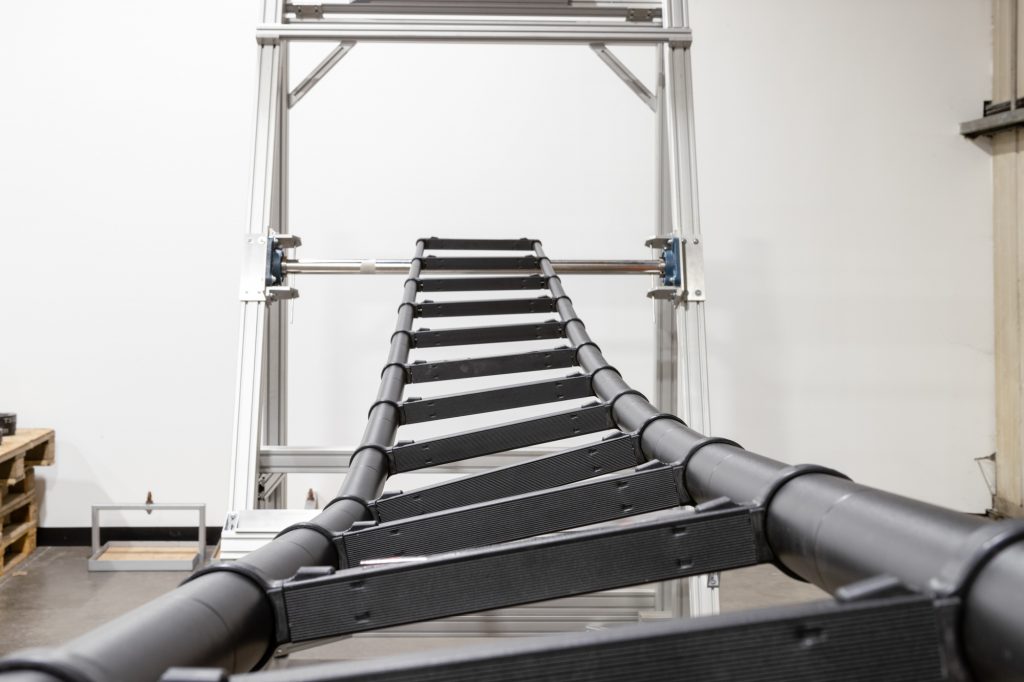
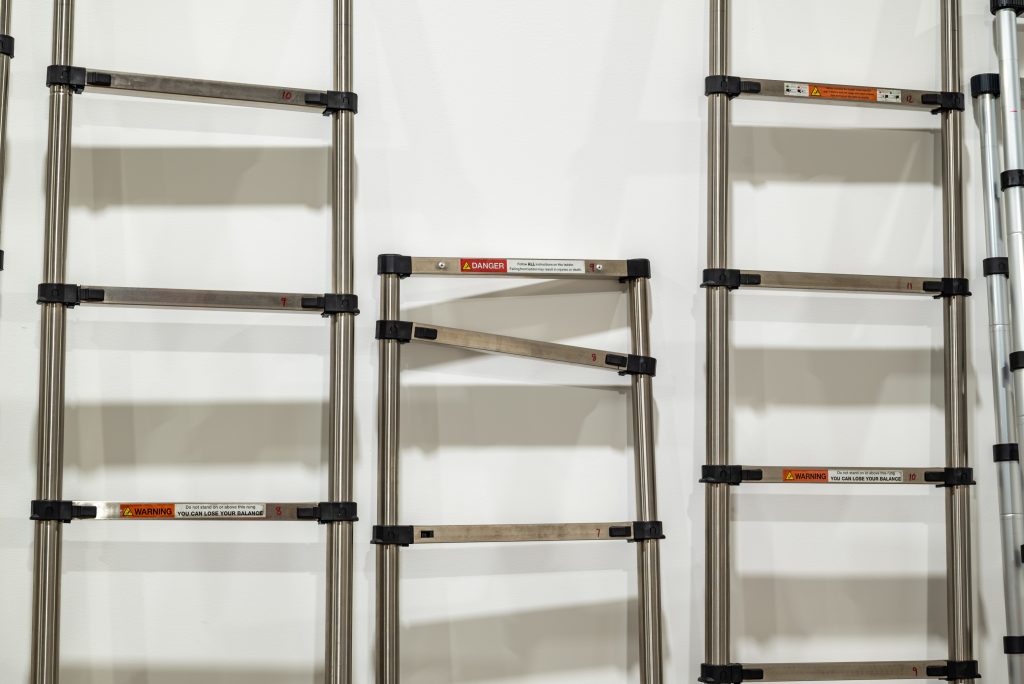
Let's be clear
Our studies show that ladders sold by some of the country’s biggest online platforms, fall well below basic safety requirements. Many of these ladders appear fit for purpose and some even display bogus compliance labelling, giving customers false assurance.
Despite these results, we want to be clear in saying there ARE also safe products out there, being sold or stocked by trusted manufacturers and suppliers.
However, we hope our research gives consumers an increased awareness around the issue and encourages them to exercise caution when buying telescopic and multi hinge-joint ladders, particularly online.
Jump straight to the following sections on this page:
Working at height can be risky enough, without the additional danger of unsafe equipment – every 11 minutes in the UK, someone attends A&E after sustaining an injury involving a ladder. We know that a fall from height can cause life changing injury, and in some cases, death.
Consumers assume products are safe
Research carried out by the Office for Product Safety and Standards (OPSS) also found only 17% of consumers consider safety at the time of purchase¹, reflecting the trust placed in suppliers, retailers, marketplaces and online platforms to only supply safe products.
Unfortunately though, many consumers are unaware that selling platforms, including online stores and social media sites, assume no responsibility for the safety of goods sold by third parties.
Lack of regulation of online platforms and marketplaces
As it stands, online marketplaces selling products supplied by third-party sellers, take little or no responsibility for preventing unsafe goods being sold on their platforms, and no legal obligation to inform consumers if they have purchased unsafe goods.
This gives rogue manufacturers and suppliers based anywhere in the world, free rein to sell unsafe – and in worst cases deadly – products direct to unsuspecting consumers in the UK. In many cases, no checks are being made at all before consumers receive the products and use them at home.
The Ladder Association calls for the following action to be taken:
1) The Government to consult closely with stakeholders and industry on the Product Regulation and Metrology Act and associated secondary legislation;
2) Introduce regulatory change to hold suppliers and online platforms accountable for selling safe products;
3) Widen the powers of the Office for Product Safety & Standards (OPSS) to obligate online marketplaces to monitor ladders offered for sale on their platforms are safe for use;
4) Where products sold online claim to have product certification, these claims are verified and proof of certification published;
5) Empower the OPSS to take representative enforcement action against the online marketplaces;
6) Strengthen consumers’ rights to bring civil actions against the online marketplaces.
Joining with industry to address this cross-sector problem
The issue of unsafe products for sale online is not constrained to our sector. We were joint signatories in March 2023, alongside the British Toy and Hobby Association and Electrical Safety First, in an open letter to Government urging them to immediately release the long-awaited Product Safety Review (PSR).
The Review – subsequently released on 2 August 2023 – contains proposals to protect consumers from buying dangerous products from online marketplaces, and afford them the same protections as they would get when buying from physical stores.
At the Ladder Association’s 2023 Annual Members’ Meeting on 22 September 2023, we gathered feedback from our members, via roundtable discussion, to help guide our formal response to the PSR consultation in October 2023.
NEW: Published Oct 2025
Our latest study investigates the safety of telescopic ladders for sale from 3rd party sellers via online platforms AND direct from leading DIY retailers.
Published April 2023
Of those telescopic ladders re-tested, ALL of them again failed the required safety tests, were non-compliant and were unsafe to use.
Published May 2022
82% of the ladders tested failed the required safety tests, were non-compliant and, in the majority of cases, were unsafe to use.
Published August 2023
We investigated the safety of popular multi hinge-joint ladders (otherwise known as multipurpose ladders) being sold on the UK market.
What’s inside the report:
• Test results of the ‘Top Ten’ multi hinge-joint ladders listed on Google (results returned using the search term ‘multipurpose ladder’);
• Further clear evidence that some manufacturers, importers and sellers are knowingly and fraudulently claiming compliance in a deliberate attempt to mislead consumers;
• The challenges faced by Trading Standards in holding overseas sellers to account;
• The latest ladder-related hospital admissions data from NHS England, NHS Wales and Public Health Scotland;
• Practical guidance for consumers when buying ladders online or in store;
• Our call for urgent action from the UK Government to make regulatory changes to hold suppliers and online platforms accountable for ensuring the products they sell are compliant and safe to use.
Summary of findings:
• Re-testing of a proportion of samples from 2022 showed that the original failures were not ‘one-offs’;
• We can publicly release the names of the products and sellers in this study (whereas previously we were unable to) – although it’s important to look beyond the names as the scale of the problem is far-reaching – this research is the tip of the iceberg;
• The same sellers continue to sell the same unsafe products with little or no concern for consumer safety;
• Products are still being falsely labelled as compliant to the product standard in a bid to deliberately mislead consumers;
• Rogue manufacturers and suppliers as it stands, have ‘free rein’ to sell unsafe goods on online marketplaces without checks;
• The Government must step in urgently to make regulatory changes and address the sale of dangerous goods from online marketplaces once and for all.
Report highlights:
• Key drivers and objectives of the campaign;
• Why we need market surveillance to improve safety and product conformity;
• Snapshot of the UK ladder market;
• Ladder accidents and how this translates to hospital admissions;
• Detailed results on our product testing;
• Our call for action from enforcement agencies, regulatory bodies and consumers to increase awareness of the problem;
• Practical guidance for consumers when buying ladders online or in store.
What’s inside the report:
• Test results of the ‘Top Ten’ multi hinge-joint ladders listed on Google (results returned using the search term ‘multipurpose ladder’);
• Further clear evidence that some manufacturers, importers and sellers are knowingly and fraudulently claiming compliance in a deliberate attempt to mislead consumers;
• The challenges faced by Trading Standards in holding overseas sellers to account;
• The latest ladder-related hospital admissions data from NHS England, NHS Wales and Public Health Scotland;
• Practical guidance for consumers when buying ladders online or in store;
• Our call for urgent action from the UK Government to make regulatory changes to hold suppliers and online platforms accountable for ensuring the products they sell are compliant and safe to use.
Our research has highlighted the increased risk of accidents for consumers who buy telescopic ladders from online platforms as opposed to physical stores.
Our consumer market research study, funded by the Office for Product Safety and Standards (OPSS), found that consumers were up to twice as likely to have an accident after buying telescopic ladders online from Amazon or eBay than those who bought from dedicated DIY retailers such as B&Q, Screwfix, Toolstation and Wickes.
The study also found nearly two thirds (62%) of respondents did not consider product safety or reference to quality marks as one of their top 3 priorities when making their purchasing decision. Instead, an even higher proportion (68%) put price as one of their top 3 priorities, with almost one third of those (29%) buying telescopic ladders on price alone.
How can you make sure the telescopic ladders you buy are safe? Here is our advice:
• Take some time to research before you buy. You can carry out a quick online check of the company or brand to check their business location and visibility in the market. If they don’t have a UK/EU address then it can make it much more difficult to contact them if you have an issue after you buy;
• Check product reviews. These are a great way of hearing first-hand from other consumers and often give valuable insight in the product quality, mainly if it falls below standard. But beware, some companies and brands post fake positive reviews, so read them carefully, note where the reviewer is based or how many reviews they have previously posted.
• Don’t make decisions solely on price. But, if something is very cheap, you should question why. That’s not to say it’s poor quality, but it’s certainly a prompt to make you do a bit more homework. Genuine quality products can cost more to manufacture due to the enhanced testing and cost of materials, but equally, a higher price doesn’t necessarily mean quality;
• Remember, online platforms take little or no responsibility for the quality or safety of the products sold on their platforms and place the responsibility for safety firmly with the seller. Don’t assume product safety and compliance checks have been carried out by them before they placed them online for sale;
• Equally, don’t assume physical stores sell only safe products. They could knowingly – or unknowingly – be stocking products that don’t meet standard. Check the labelling for print quality or spelling errors, check the product quality as best you can, and speak to the retailer themselves if you have any questions;
• Avoid ladders that are CE or UKCA marked. Despite what you might think, ladders cannot be CE or UKCA marked, so avoid any that bear that marking;
• Check that the products are certified by a third-party Conformity Assessment Body. You can contact the Assessment Body (such as Test & Research Centre, TÜV, BSI to name a few) to verify the authenticity.
• Buy from a Ladder Association member. Members are committed to high standards of safety, and by joining the Association, they pledge to only make or sell ladders that comply with current product standards and/or are certified by a third-party Conformity Assessment Body. A full list of members can be found on the Ladder Association website:
https://ladderassociation.org.uk
• When you receive your ladder, check it. Check the product, the instruction manual (every ladder should come with one) and the labelling on the ladder itself;
• If you think the ladder is unsafe, dangerous or not made to standard, firstly, don’t use it! You should then contact your local Trading Standards team, or you can REPORT UNSAFE LADDERS HERE >
The telescopic and multi hinge-joint ladders tested in our campaign were put through their paces in a series of safety critical tests at the UKAS accredited not-for-profit UK testing facility, Test & Research Centre. The centre specialises in the certification and testing of access equipment.
Above: We give an insight into our latest product testing for the 2025 Telescopic Ladder Report.
Above: John Darby, General Manager, Test & Research Centre carrying out product testing for our 2022 Telescopic Ladder Report.
Pictured below: Visible product failures during our testing programmes.
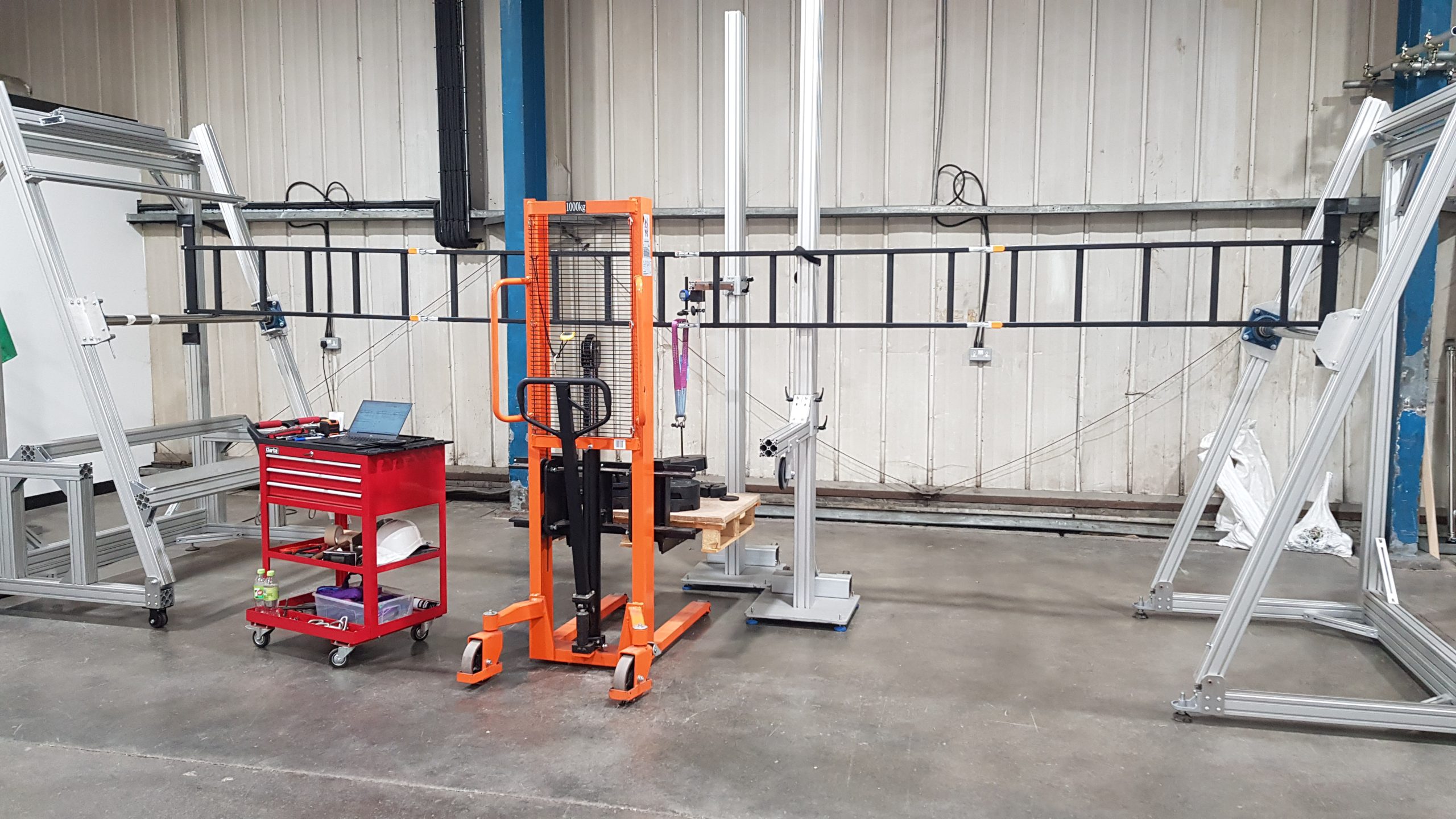

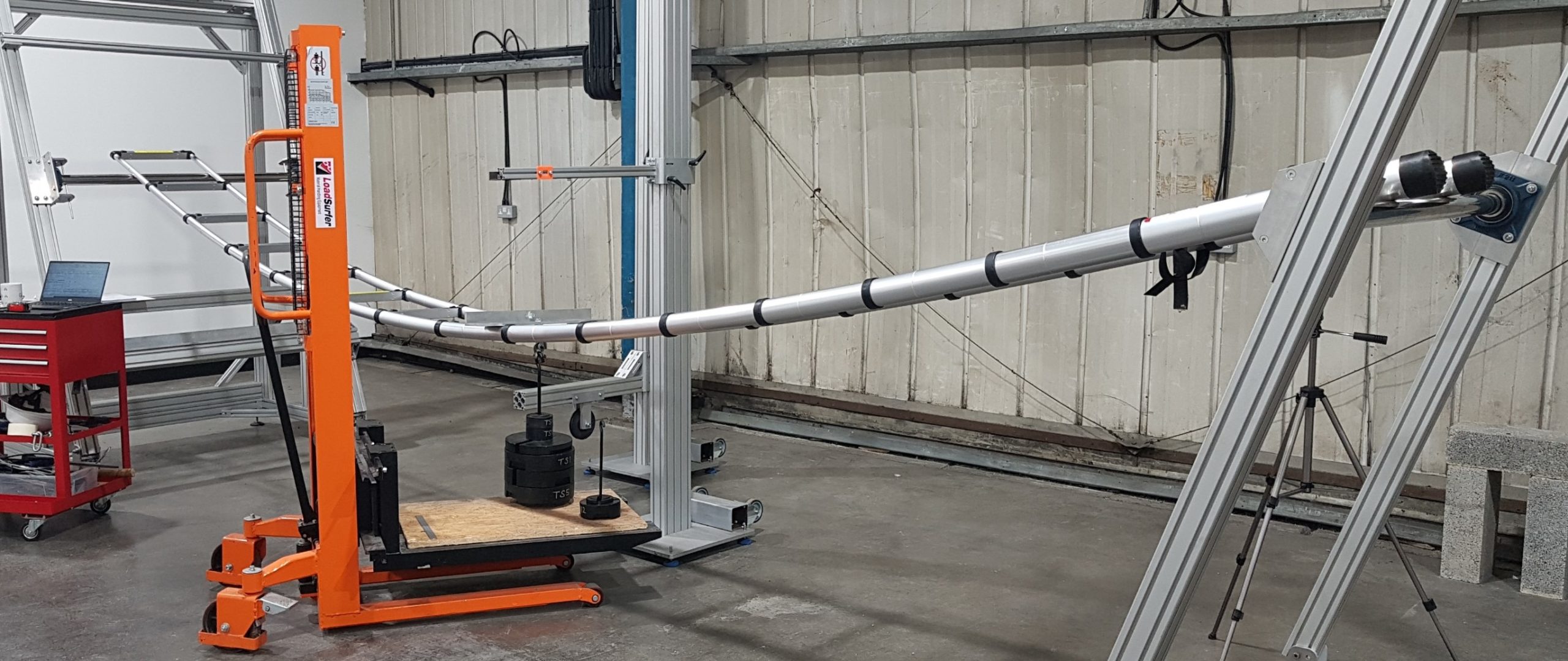
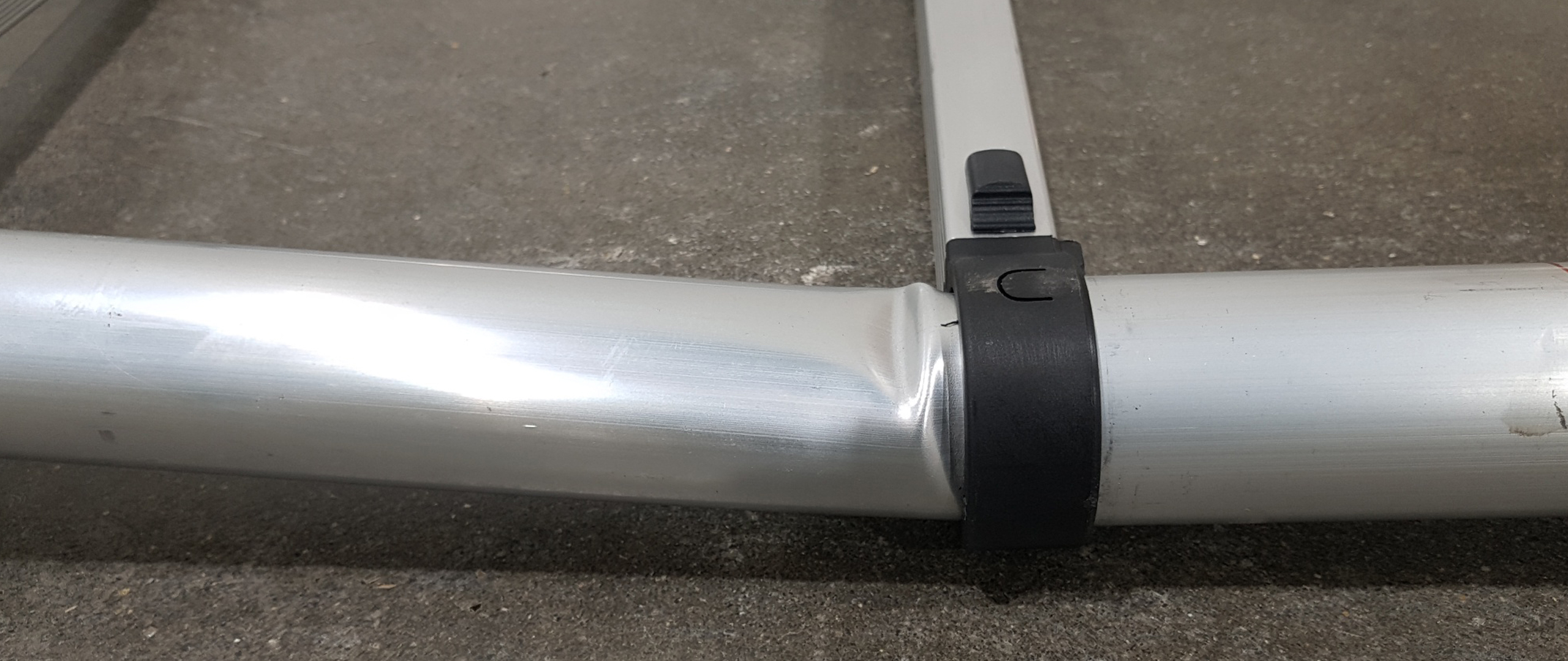
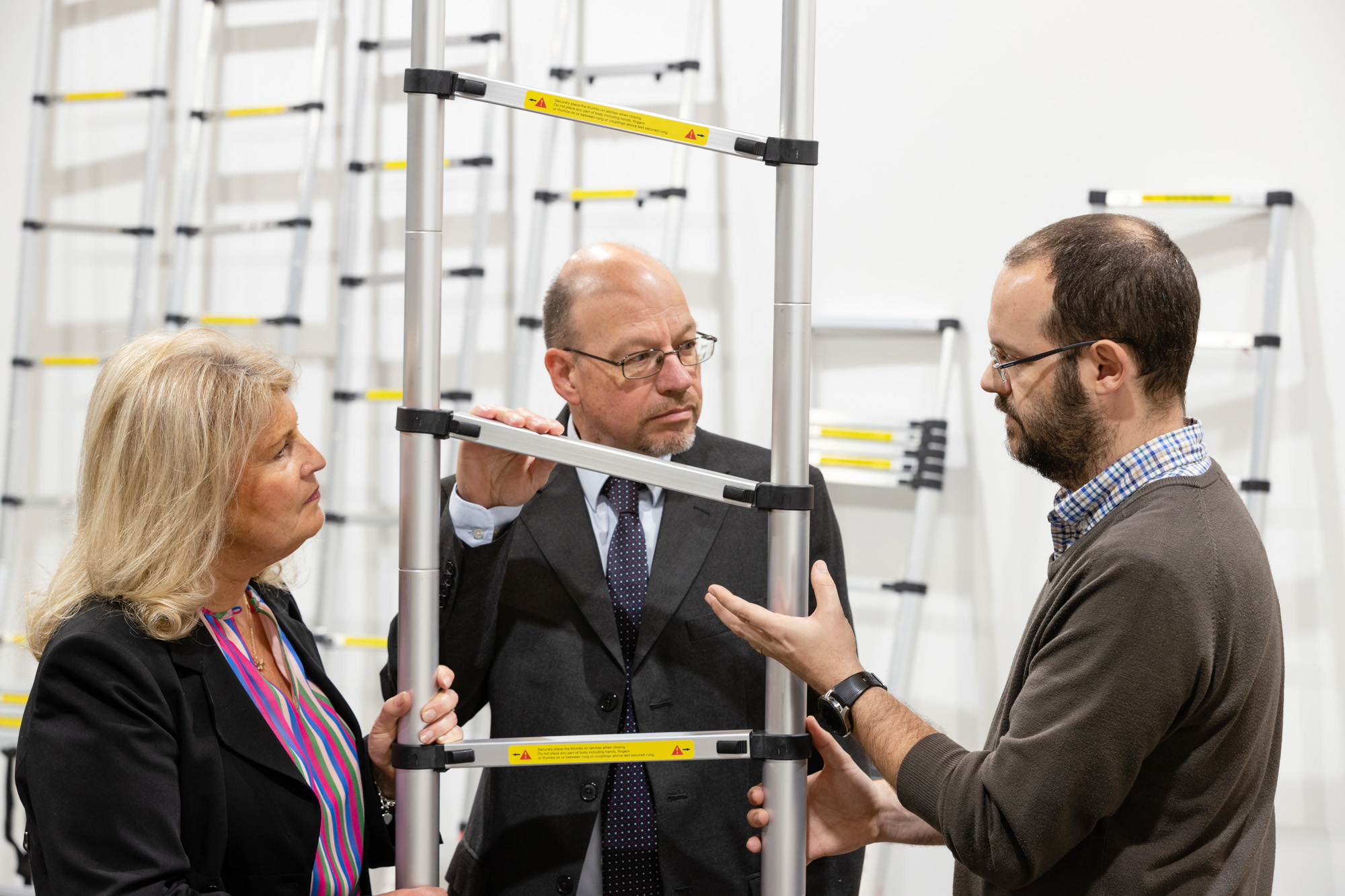
Pictured left to right: Gail Hounslea, Chairman of the Ladder Association, Andrew Fayers, Senior Trading Standards Officer, Cambridgeshire County Council on behalf of EETSA (for the 2022 Telescopic Report), and John Darby, General Manager, Test & Research Centre.
“EETSA and Suffolk Trading Standards Imports Team have found it invaluable to work with the Ladder Association on this project.
From the samples provided by EETSA, over half failed the appropriate tests to the applicable safety standard. For those telescopic ladders identified as non-compliant, action has been taken to ensure they are removed from sale.
EETSA would advise consumers to take time to research before buying, particularly online, buy from reputable sources and check product reviews. If consumers have concerns about the safety of a product before or after purchase, it should be reported to Trading Standards “
Vicki Burch, Chair of the East of England Trading Standards Association (EETSA) Product Safety Group, referencing their involvement in the 2022 Telescopic Ladder Study.
Following our latest study, the Ladder Association are calling for:
1) The Government to consult closely with stakeholders and industry on the Product Regulation and Metrology Act and associated secondary legislation;
2) Introduce regulatory change to hold suppliers and online platforms accountable for selling safe products;
3) Widen the powers of the Office for Product Safety & Standards (OPSS) to obligate online marketplaces to monitor ladders offered for sale on their platforms are safe for use;
4) Where products sold online claim to have product certification, these claims are verified and proof of certification published;
5) Empower the OPSS to take representative enforcement action against the online marketplaces;
6) Strengthen consumers’ rights to bring civil actions against the online marketplaces.
The Product Regulation and Metrology (PRAM) Act
As part of the King’s Speech on 17 July 2024, the new UK Government proposed to present the Product Regulation and Metrology Bill, a critical piece of legislation that will affect all businesses involved in manufacturing, importing and selling products in the UK.
The Ladder Association is pleased to report that the bill was granted Royal Assent on 21 July 2025.
Under the new Product Regulation and Metrology Act, the Government intends to introduce requirements for online marketplaces at the earliest opportunity to update their responsibilities. This would ensure a level playing field between the high street and online marketplaces – something the Ladder Association has been calling on the Government to do for many years.
This Act is good news not only for the ladder industry, but should provide more much-needed protection for consumers when buying all manner of height safety products – or any products, of any kind, for the home and workplace.
We will keep you updated on the laws that follow.
What about your existing ladders?
It’s estimated there are over 2 million ladders in regular use in the UK, so there’s a very high chance many people will already own a ladder of some type at home or at work.
How do you know your current ladder is safe – and are we saying to buy new ones? The short answer is no. We don’t expect or advise every ladder owner to buy a new ladder. But, to help you determine if your existing ladder is safe to use, we do suggest you:
• Check your ladder before you use it. Read the user instructions from the manufacturer and carry out a ‘pre-use’ check to spot an visual defects. The check should include:
• the stiles – make sure they are not bent or damaged, as the ladder could buckle or collapse;
• the feet – if they are missing, worn or damaged the ladder could slip. Also check the ladder feet when moving from soft/dirty ground (eg dug soil, loose sand/stone, a dirty workshop) to a smooth, solid surface (eg paving slabs), to make sure the actual feet and not the dirt (eg soil, chippings or embedded stones) are making contact with the ground;
• the rungs – if they are bent, worn, missing or loose, the ladder could fail;
• the locking mechanism – does the mechanism work properly? Are components or fixings bent, worn or damaged? If so, the ladder could collapse. Ensure any locking bars are fully engaged;
• if it’s a stepladder, check the platform – if it is split or buckled, the ladder could become unstable or collapse;
• if it’s a stepladder, check the steps or treads – if they are contaminated, they could be slippery; if the fixings are loose on the steps, they could collapse.
If you spot any of the above defects, don’t use the ladder! If you’re using the ladder at work, make sure you notify your employer.
• Check the ladder labelling. All ladders should now be designed and manufactured to the current EN 131 standard only, so if you have a newer ladder you should see that label on it. If it’s an old ladder, you might see markings for BS 2037 and BS 1129. These are old product standards and no reputable company is making or supplying ladders to these standards anymore. If you do have ladders that were made to the old standards, you may continue to use them if you are sure they are in good condition (as per the above pre-use checks).
If you have ladders and you are not sure if they comply with the obsolete and withdrawn standards or the latest EN131 standard (because you don’t have a record or the labels are gone), then we advise that you stop using them immediately. If you cannot be sure, you should scrap them properly and replace them with ladders which comply with the current EN131 standard.
Remember, ladders cannot be CE marked, so avoid any that bear that marking;
• Think back to where you bought your ladder. Did you buy it online or in store? Refer back to our earlier guidance for buying new ladders.
Remember, if you think the ladder is unsafe, dangerous or not made to standard, don’t use it!
Looking for safe ladders? Choose ladders from Ladder Association manufacturer or supplier members. FIND MEMBERS >
Other useful information
Buy from a Ladder Association member
Looking for safe ladders? Choose ladders from Ladder Association manufacturer or supplier members. FIND MEMBERS >
Practical, accredited ladder training
It might sound strange to some people to think they need trained to use a ladder. They’re simple, right?
Yes, on the face of it they are. And they can be a sensible and practical solution for low risk and short duration work at height.
Although ladders are fairly simple pieces of work equipment, you must still be ‘competent’ to use them, whether at work or at home. That’s because you’re working at height, which always carries risks, and it’s important you know how to do it safely.
Ladder Association training is about more than just using the ladder; it’s about understanding when it’s right to use a ladder (and when it’s not!), choosing the right ladder and then understanding the simple steps to take to use the ladder safely.
Accredited training is available from approved Ladder Association training centres across the UK and includes the following courses for ladder users and those who manage ladder use at work:
* Ladders and Stepladders for Users
* Ladders and Stepladders Inspection
* Steps and Step Stools for Users
* Ladders and Stepladders for Managers
INTERESTED? FIND YOUR NEAREST TRAINING CENTRE >

More ladder safety guidance
Explore our website for MORE FREE GUIDANCE, including information on telescopic ladders and changes to ladder standards.
Keep in touch
If you want to stay updated on the latest ladder safety news, resources and events:
• Join our mailing list – SUBSCRIBE HERE >
Press enquiries
For all press enquiries specifically relating to our ‘Step Up to Safe Ladders’ Campaign, please contact our Marketing Team:
No Falls Foundation
The Ladder Association proudly supports the work of the No Falls Foundation, an important charity dedicated to preventing falls from height and falling objects, and supporting those affected by a fall. The charity offers a range of guidance and support:
Getting the support you need after a fall from height – support pack
Subscribe to the No Falls Foundation newsletter for a bi-monthly round-up of work at height news and views.
If you’ve had a fall from height and would like to share your story, please contact No Falls Foundation.
If you or your organisation can support the Foundation in any way, they would love to hear from you.

References:
¹OPSS – Consumer attitudes to product safety:
https://assets.publishing.service.gov.uk/government/uploads/system/uploads/attachment_data/file/923600/consumer-attitudes-product-safety-report.pdf





